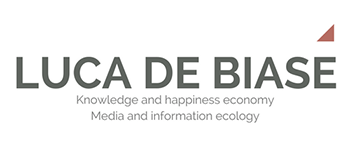Seth Godin ha raccolto pensieri eccellenti per un libro pubblicato online. Il suo contributo è sulla parola “generosità”.
“When the economy tanks, it’s natural to think of yourself first. You have a family to feed a
mortgage to pay. Getting more appears to be the order of business.
It turns out that the connected economy doesn’t respect this natural instinct. Instead, we’re rewarded for being generous. Generous with our time and money but most important generous with our art.
If you make a difference, people will gravitate to you. They want to engage, to interact and to
get you more involved.
In a digital world, the gift I give you almost always benefits me more than it costs.
If you make a difference, you also make a connection. You interact with people who
want to be interacted with and you make changes that people respect and yearn for.
Art can’t happen without someone who seeks to make a difference. This is your art, it’s what
you do. You touch people or projects and change them for the better.
This year, you’ll certainly find that the more you give the more you get.
Seth Godin is a blogger and speaker. His new book Linchpin comes out in January.“
Il valore si vede nella connessione. Non nel privare l’altro di ciò che tu hai. La tua stessa identità dipende dalla relazione. Il collegamento decisivo, con l’identità, viene dallo studio di Cynthia Kurtz, pubblicato su FirstMonday. Che parla anche di come la struttura di un servizio online possa favorire o sfavorire la collaborazione, in chiave appunto identitaria.
“This paper brings together three strands of theory about how people
interact in order to achieve common goals: aspects of identity
(categorical, relational and positional); types of identity interaction
(selection, mobilization and commitment); and conditions of tie
formation and dissolution (boundary areas on the Cynefin sensemaking
framework). The paper explains how the three strands come together to
form a “braid” of interaction contexts that influence the needs of
those interacting. The braid is
used to consider design issues in software that helps people interact,
both in a general survey of social software and in specific response to
some influential papers in the area. Special attention is given to
interactions surrounding the collaborative development of open source
software and information.“






pensieri eccellenti, ma i fonts sono troppo piccoli!
“In a digital world, the gift I give you almost always benefits me more than it costs”.
Questa frase in particolare mi ha fatto venire in mente il saggio di Carliss Y. Baldwin e Eric von Hippel (2009), ‘Modeling a Paradigm Shift: From Producer Innovation to User and Open Collaborative Innovation’, scaricabile all’indirizzo: http://hbswk.hbs.edu/item/6325.html
L’articolo esplora tre modelli di innovazione: promossa dal singolo utente, dal produttore, o il modello di ‘open collaborative innovation’. Gli autori intendono promuovere l'”openness” nelle organizzazioni, puntando appunto sulla ‘convenienza’ della condivisione di idee:
“evidence has now accumulated that innovators who elect to freely reveal their innovations, can gain significant private benefits – and also avoid some private costs”.